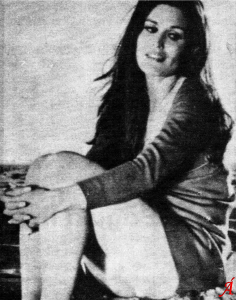An Update to
“An Intro to Chapter 16 of Marcos’ Lovie Dovey”
Although undeniably a star during her brief moment in Philippine pop history, Dovie Beams will have to be counted as an abject failure in terms of her Hollywood aspirations. She started with supporting roles in two Westerns, Wild Wheels (Ken Osborne, 1969) and Guns of a Stranger (Robert Hinkle, 1973). The genre traditionally gave prominence to male heroes, with a notable exception in Nicolas Ray’s Johnny Guitar (1954), repudiated by its director for Joan Crawford’s insistence on having more screen time than the title character; ironically JG became valued, and rightfully so, for ushering in a new stage in Western genre development, where its once-overlooked types of characters (women, outlaws, Native Americans and other people of color) could now be permitted to present their narratives from their own respective perspectives.
11011Unfortunately the Marcos affair decimated whatever potential Beams was hoping to build up. Her only Hollywood comeback consisted of a marginalized appearance in an otherwise admired comedy, John Landis’s The Kentucky Fried Movie (1977). On the other hand, she was lucky her sole starring role, in Jerry Hopper’s Maharlika (1970), was little-seen because of the scandal she caused and gutsily exacerbated via her lurid tell-all press conference in 1970. Maharlika was reportedly retitled Guerrilla Strike Force and screened in Guam, presumably to recover whatever funds it could hope to generate. Upon the ouster of the Marcoses, its original title was restored and it finally had its premiere run in the Philippines in 1987.
11011Maharlika affirms for posterity that whatever talents Beams possessed, film performing could never be counted as one of them. Like her Western projects, Maharlika’s war-film material situated her character secondary to the hero (actually a stand-in for Marcos, who was out to make a definitive demonstration that he deserved to earn all the war medals he falsely claimed to have garnered from the US government). She complained of having been dismissively treated by her leading man, TV and cult-film star Paul Burke, but we can only speculate as to his motives. Her notoriety might have preceded her, although just as likely, he could have observed how she (quite literally) tackled her scenes.
11011Every shot Beams appears in is filled with a spirited eagerness, celluloid testament to her resolve not to waste any of the opportunity that she had worked long and hard for, not least of which was the degradation of her function as the future dictator’s sex object, pimped by apparently influential aides whom she knew only by their aliases. Regrettably, she lacked both expert coaching as well as the experience of tempering and matching her execution from one scene to the next, not to mention building up to a carefully modulated character presentation. Her initial appearance as a country maiden confronted by marauding Japanese soldiers and sexually assaulted by them in her backyard, displays a welter of externalized responses too hyperkinetic to be plausible; these types of inadvertently laughable renditions would have sealed her fate as performing artist, had Maharlika been more widely seen.
11011An obituary page for “Dovie Leona Osborne Boehms Beam Villagran” is maintained at Dignity Memorial; her movie surname was presumably a modification of “Boehms,” her first husband’s family name. (Greetings from people with “Marcos” and “Villagran” in their names might help dispel any doubt regarding the validity of the website post.) Her Wikipedia entry as of this moment includes a still-to-be-authenticated cause of death (lung cancer and comorbidity due to alcohol and tobacco use), and reports a recent attempt by Imelda Marcos, in a 2022 TV interview by Winnie Monsod, to deny that there ever was an affair between her late hubby and Beams – a disavowal on the same order as her family’s protestation that the Marcoses’ conjugal dictatorship was benign and untainted by record-breaking plunder.
11011A sober-sounding comment on a video upload at the Imperiya.By News Info Center, by a netizen with the initials “RD,” who claims to be a distant relative of Beams, alleges the following: that she’d abandoned her eldest child, who nevertheless subsequently managed to secure bit parts in Beams’s film projects; that she had three grandchildren and a great grandchild by the time she died; that while she spent a spell in prison for fraud, her then-husband Sergio de Villagran managed to flee the US; that a man who claimed to be her son by Marcos managed to befriend her eventually (Dovie Beams love child indeed); and that some moon rocks, officially the property of the US government, were gifted her by “Fred” and are now in her daughter’s possession. Some of these claims obviously call out for investigative reporting, but as to whether the Beams mystique will persist to that extent, all we can do is look to the future.
11011Meanwhile, the Dovie Beams entry in Caroline Hau’s A Glossary of the Marcos Era (1965-1986) in the Philippines at her Ikangablog is packed with all the available essential information you could ask for, duly cited and cross-referenced. Hie on over but make sure you’ve got some extra time to spare, in case the other entries prove irresistible – because they will.
Excursus
 On August 17, 2023, James de la Rosa posted, on his “Baul ni Juan” page on Facebook, the newspaper layout (plus supplemental pics) of Gerardo de Leon’s The Gold Bikini, a 1967 release that seemed to foreshadow Maharlika: it featured, in Elizabeth Thompson, what period slang would have described as a “white-leghorn” actress; the lead actor’s code name was Agent 777 (the numerologically obsessed Marcos’s favorite number); and the lead actor’s family name was … Marcos. No serious connection can be made between this and Beams’s project, except for the (still-distant) possibility that Marcos or one of the film producers may have been inspired by it. Pending further though unlikely disclosures, we can chalk this up to one of those serendipitous coincidences that a thriving popular culture occasionally offers up.
On August 17, 2023, James de la Rosa posted, on his “Baul ni Juan” page on Facebook, the newspaper layout (plus supplemental pics) of Gerardo de Leon’s The Gold Bikini, a 1967 release that seemed to foreshadow Maharlika: it featured, in Elizabeth Thompson, what period slang would have described as a “white-leghorn” actress; the lead actor’s code name was Agent 777 (the numerologically obsessed Marcos’s favorite number); and the lead actor’s family name was … Marcos. No serious connection can be made between this and Beams’s project, except for the (still-distant) possibility that Marcos or one of the film producers may have been inspired by it. Pending further though unlikely disclosures, we can chalk this up to one of those serendipitous coincidences that a thriving popular culture occasionally offers up.
11011Where TGB departs from Maharlika is in its high-caliber team of creatives: aside from having been directed by then-future National Artist de Leon, the screenplay was written by Cesar Amigo, and cinematography was handled by Mike Accion. It moreover featured pentjak, “an Indonesian art of self-defense … which is said to be a fight to the finish” that (according to the trainer) “originated during the days of the Dutch occupation in Indonesia when freedom fighters had to learn the art for lack of modern combat equipment” (Screen Stardom 4.7, 1967, qtd. in “Baul ni Juan”).
Á!













 ORCID ID
ORCID ID 